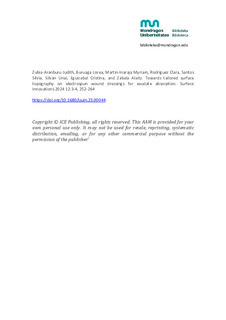
Izenburua
Towards tailored surface topography on electrospun wound dressings for exudate absorptionEgilea (beste erakunde batekoa)
Beste instituzio
BioCruces Health Research InstituteBertsioa
Postprinta
Eskubideak
© 2023 EmeraldSarbidea
Sarbide irekiaArgitaratzailearen bertsioa
https://doi.org/10.1680/JSUIN.23.00044Non argitaratua
Surface Innovations Vol. 12. N. 3-4. N. art. 2300044, 2024Argitaratzailea
EmeraldGako-hitzak
Absorption
characterisation
electrospinning
PCL (polycaprolactone) ... [+]
characterisation
electrospinning
PCL (polycaprolactone) ... [+]
Absorption
characterisation
electrospinning
PCL (polycaprolactone)
Sterilisation
surface modification
surface roughness
surface texture [-]
characterisation
electrospinning
PCL (polycaprolactone)
Sterilisation
surface modification
surface roughness
surface texture [-]
Eremua (UNESCO Sailkapena)
Zientzia TeknologikoakDiziplina (UNESCO Sailkapena)
Teknologia eta ingeniaritza mekanikoakLaburpena
Since electrospinning can generate micro- to nanometre-scale fibres, it is widely used for fabricating wound dressings. Electrospun scaffolds with defined three-dimensional patterns at the mat surface ... [+]
Since electrospinning can generate micro- to nanometre-scale fibres, it is widely used for fabricating wound dressings. Electrospun scaffolds with defined three-dimensional patterns at the mat surface can be efficiently fabricated using textured collectors that transfer the topography during the manufacturing process. However, the efficacy of surface pattern transfer from the collector to the mat, the correlation between the topography and the absorption capability and the effect of sterilisation on absorption have not yet been analysed. In this study, textured patterns were imprinted over polycaprolactone electrospun mats using textured collectors. The successful transferability of the patterns was quantified through height, hybrid and functional surface topography parameters. Additionally, ethylene oxide, hydrogen peroxide (H2O2) and ultraviolet (UV) sterilisation methods were tested, of which only UV preserved the morphological and functional integrity of the mat. Finally, fibroblasts were used to analyse the cytotoxicity and cellular response of the dressings, verifying their biocompatible nature. This study demonstrates that absorption capacity can be modulated by the surface texture of the wound dressing. The S dq and S dr parameters were identified as key surface characteristics for enhancing absorption capacity and yielded an increase of up to 176.76% compared with the non-textured control, thus revealing the potential of surface functionalisation for increasing exudate absorption. [-]
Finantzatzailea
Gobierno VascoGobierno Vasco
Gobierno Vasco
Programa
Ayudas a proyectos de investigación y desarrollo en salud 2020Ayudas a proyectos de investigación y desarrollo en salud 2021
Ayudas a proyectos de investigación y desarrollo en salud 2022
Zenbakia
20203330322021333057
2022333044
Proiektua
Estandarización en la obtención y preservación de plasma rico en plaquetas alogénico, creación de apósitos 3D biodegradables y biocompatibles con factores plaquetares para la curación de heridas crónicas (ALOPRP3D)Creación de apósitos con plasma rico en plaquetas alogénicos para la curación de heridas crónicas (ALOPRP3D II)
Creación de apósitos con plasma rico en plaquetas alogénicos para la curación de heridas crónicas (ALOPRP3D III)




















